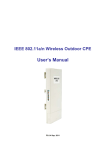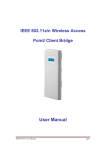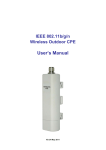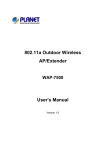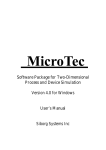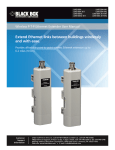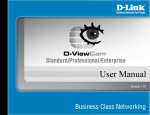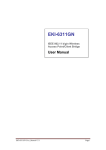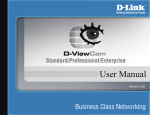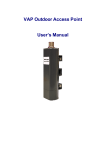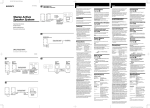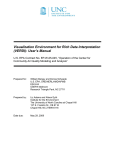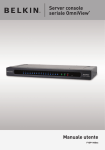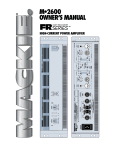Download WLAN-LCCPE516-1 User Manual - L
Transcript
IEEE 802.11a/n Wireless Outdoor CPE
User’s Manual
V3.0.4 April 2011
Copyright
Copyright © 2010 all rights reserved. No part of this publication may be reproduced, adapted, stored in
a retrieval system, translated into any language, or transmitted in any form or by any means without
the written permission of the supplier.
About This Manual
This user manual is intended to guide professional installer to install the IEEE 802.11a/n Wireless CPE
and how to build the infrastructure centered on it. It includes procedures to assist you in avoiding
unforeseen problems.
Conventions
For your attention on important parts, special characters and patterns are used in this manual:
Note:
This indicates an important note that you must pay attention to.
Warning:
This indicates a warning or caution that you have to abide.
Bold: Indicates the function, important words, and so on.
Federal Communication Commission Interference Statement
This equipment has been tested and found to comply with the limits for a Class B digital device,
pursuant to Part 15 of the FCC Rules.
These limits are designed to provide reasonable protection
against harmful interference in a residential installation.
This equipment generates uses and can
radiate radio frequency energy and, if not installed and used in accordance with the instructions, may
cause harmful interference to radio communications.
However, there is no guarantee that
interference will not occur in a particular installation.
If this equipment does cause harmful
interference to radio or television reception, which can be determined by turning the equipment off and
on, the user is encouraged to try to correct the interference by one of the following measures:
-
Reorient or relocate the receiving antenna.
-
Increase the separation between the equipment and receiver.
-
Connect the equipment into an outlet on a circuit different from that to which the receiver is
connected.
-
Consult the dealer or an experienced radio/TV technician for help.
This device complies with Part 15 of the FCC Rules. Operation is subject to the following two
conditions: (1) This device may not cause harmful interference, and (2) this device must accept any
interference received, including interference that may cause undesired operation.
FCC Caution: Any changes or modifications not expressly approved by the party responsible for
compliance could void the user's authority to operate this equipment.
FCC Radiation Exposure Statement:
This equipment complies with FCC radiation exposure limits set forth for an uncontrolled environment.
To avoid the possibility of exceeding radio frequency exposure limits, you shall beep a distance of at
least 100cm between you and the antenna of the installed equipment.
This transmitter must not be
co-located or operating in conjunction with any other antenna or transmitter.
The availability of some specific channels and/or operational frequency bands are country
dependent and are firmware programmed at the factory to match the intended destination. The
firmware setting is not accessible by the end user.
Content
Chapter 1 Introduction ...................................................................................................................... 1 Introduction ...................................................................................................................................... 1 Appearance ..................................................................................................................................... 1 Key Features ................................................................................................................................... 2 Typical Application ........................................................................................................................... 2 Chapter 2 Hardware Installation ....................................................................................................... 3 Preparation before Installation ......................................................................................................... 3 Professional Installation Required ................................................................................................ 3 Safety Precautions ....................................................................................................................... 3 Installation Precautions ................................................................................................................ 4 Product Package .......................................................................................................................... 4 Hardware Installation ....................................................................................................................... 6 Connect up ................................................................................................................................... 6 Using the External Antenna .......................................................................................................... 9 Pole Mounting .............................................................................................................................10 Chapter 3 Basic Settings ................................................................................................................. 11 Factory Default Settings.................................................................................................................. 11 System Requirements.....................................................................................................................12 How to Login the Web-based Interface ...........................................................................................12 Basic System Settings ....................................................................................................................15 Time Settings ..................................................................................................................................18 RADIUS Settings ............................................................................................................................19 Firewall Settings .............................................................................................................................20 Basic Wireless Settings ..................................................................................................................23 Site Survey .....................................................................................................................................26 VAP Profile Settings ........................................................................................................................26 VLAN Tab........................................................................................................................................28 Chapter 4 Advanced Settings ..........................................................................................................29 Advanced Wireless Settings ...........................................................................................................29 Wireless Security Settings ..............................................................................................................32 Data Encryption and Authentication Settings ...............................................................................32 Access Control ............................................................................................................................34 WDS Settings .................................................................................................................................35 Chapter 5 Management ....................................................................................................................36 Remote Management .....................................................................................................................36 SNMP Management........................................................................................................................36 Configure SNMPv3 User Profile ..................................................................................................38 Upgrade Firmware ..........................................................................................................................39 Backup/ Retrieve Settings ...............................................................................................................40 Restore Factory Default Settings ....................................................................................................40 Reboot ............................................................................................................................................41 Password ........................................................................................................................................42 Chapter 6 Monitoring Tools .............................................................................................................43 System Log .....................................................................................................................................43 Site Survey .....................................................................................................................................43 Ping Watch Dog ..............................................................................................................................44 Date Rate Test ................................................................................................................................45 Antenna Alignment ..........................................................................................................................45 Speed Test ......................................................................................................................................46 Chapter 7 Status ...............................................................................................................................47 View Basic Information ...................................................................................................................47 View Association List ......................................................................................................................47 View Network Flow Statistics ..........................................................................................................48 View ARP Table ..............................................................................................................................49 View Bridge Table ...........................................................................................................................50 View Active DHCP Client Table .......................................................................................................50 View Network Activities ...................................................................................................................51 Chapter 8 Troubleshooting ..............................................................................................................52 Appendix A. ASCII ............................................................................................................................54 Appendix B. SSH Settings ...............................................................................................................55 Appendix C. GPL Declamation ........................................................................................................63 Appendix D. Country Channel List .................................................................................................68 TABLE
Table 1 Factory Default Settings ......................................................................................................... 11 Table 2 Table 2 ACSII...........................................................................................................................57
Table 3 Table 3 Public Software Name and
Description……………………………………………………59
Chapter 1 Introduction
Introduction
Designed for outdoor environment application, the IEEE 802.11a/n Wireless Outdoor CPE is a
high-performance 802.11 a/n 2x2 MIMO broadband solution that provides fast and reliable wireless
network coverage. Designed with IEEE 802.11n draft 2.0 standard, high output power and built-in
16dBi dual-polarity antenna makes it possible to deliver several times faster data rate than normal
wireless device and higher bandwidth with longer range for outdoor applications.
The IEEE 802.11a/n Wireless Outdoor CPE supports four wireless communication connectivity (AP,
Wireless Client, WDS and AP Repeater), allowing for various application requirements thus helping to
find the key to the “last mile” with least effort.
With high output power and reliable performance, the IEEE 802.11a/n Wireless Outdoor CPE is an
ideal wireless broadband solution for wireless Internet service providers and system integrators!
Appearance
Figure 1 IEEE 802.11a/n Wireless Outdoor CPE
Key Features
Compliant with IEEE 802.11a and IEEE 802.11n as well
Support Power Through Ethernet which is supplied with 15V.
High reliable watertight housing endures almost any harsh environments
Four operating modes including AP, Wireless Client, WDS and AP Repeater
Support 64/128/152-bit WEP and 802.1X, WPA, WPA2, WPA&WPA2,WPA-PSK, WPA2-PSK, and
WPA-PSK&WPA2-PSK etc
User-friendly Web and SNMP-based management interface
Typical Application
This section describes the typical applications of the IEEE 802.11a/n Wireless Outdoor CPE. By
default, it is set to AP mode which allows it to establish a wireless coverage; besides, it is also able to
join any available wireless network under wireless client mode. the IEEE 802.11a/n Wireless Outdoor
CPE is able to deliver stable and efficient broadband connectivity for various applications.
Figure 2 Typical Application
Chapter 2 Hardware Installation
This chapter describes safety precautions and product information you have to know and check before
installing the IEEE 802.11a/n Wireless Outdoor CPE.
Preparation before Installation
Professional Installation Required
Please seek assistance from a professional installer who is well trained in the RF installation and
knowledgeable in the local regulations.
Safety Precautions
1.
To keep you safe and install the hardware properly, please read and follow these safety
precautions.
2.
If you are installing the IEEE 802.11a/n Wireless Outdoor CPE for the first time, for your safety
as well as others’, please seek assistance from a professional installer who has received safety
training on the hazards involved.
3.
Keep safety as well as performance in mind when selecting your installation site, especially
where there are electric power and phone lines.
4.
5.
When installing the CPE, please note the following things:
Do not use a metal ladder;
Do not work on a wet or windy day;
Wear shoes with rubber soles and heels, rubber gloves, long sleeved shirt or jacket.
When the system is operational, avoid standing directly in front of it. Strong RF fields are present
when the transmitter is on.
Installation Precautions
To keep the IEEE 802.11a/n Wireless Outdoor CPE well while you are installing it, please read and
follow these installation precautions.
1.
Users MUST use a proper and well-installed surge arrestor with the CPE; otherwise, a random
lightening could easily cause fatal damage to the unit.
EMD (Lightning) DAMAGE IS NOT
COVERED UNDER WARRNTY.
2.
Users MUST use the “Power cord & POE Injector” shipped in the box with the CPE.
Use of
other options will cause damage to the unit.
3.
Users MUST power off the IEEE 802.11a/n Wireless Outdoor CPE first before connecting the
external antenna to it. Do not switch from built-in antenna to the external antenna from WEB
management without physically attaching the external antenna onto the CPE; otherwise,
damage might be caused to the device itself.
Product Package
The product package you have received should contain the following items. If any of them are not
included or damaged, please contact your local vendor for support.
IEEE 802.11a/n Wireless Outdoor CPE
×1
Pole Mounting Ring
×2
Power Cord & POE Injector
×1
Product CD
×1
Note:
Product CD contains Quick Installation Guide and User Manual!
Pole Mounting Ring
Power Cord & POE Injector
Warning:
Users MUST use the “Power cord & POE Injector” shipped in the box with the IEEE
802.11a/n Wireless Outdoor CPE. Use of other options will cause damage to the
unit.
Hardware Installation
Connect up
1.
The bottom of IEEE 802.11a/n wireless outdoor CPE is a movable cover.
Loosen the screw
with a Philips screwdriver. Grab the cover and pull it back harder to take it out as the figure
shown below.
Figure 3 Move the Cover
2.
Plug a standard Ethernet cable into the RJ45 port labeled “LAN 1”.
the RJ45 port labeled “LAN 2”.
Figure 4 Cable Connection
Do not plug the cable into
The secondary Ethernet port (labeled LAN 2) is for IP video integration.
To use it you need to
enable the secondary port in advance before connecting with the IP camera from the CPE’s
Web Management as shown below.
3.
Take out the power cord and POE injector from the gift box, and plug the power cord into the DC
port of the POE injector as the below picture shows.
Figure 5 Connect to POE Injector
4.
Put what in the Step.2 and Step.3 together by plugging the other side of the Ethernet cable in
the Step.2 into the POE port of the POE injector in the Step.3.
set will be like the following picture:
When you finish the Step.4, the
Figure 6 Plug the Ethernet cable to the RJ-45 jack of the injector
5.
Press the black PWR button beside the LAN 1 Ethernet port.
6.
Attach and fasten the removable cover to the bottom of the unit with the screw.
7.
Power on the IEEE 802.11a/n Wireless Outdoor CPE by plugging the power adapter to the
power socket.
Using the External Antenna
The IEEE 802.11a/n Wireless Outdoor CPE provides two reverse SMA antenna connectors if you
prefer to use the external antenna for your application instead of the built-in directional antenna,
please follow the steps below.
1.
Remove the two plugs as circled below:
2.
Connect your external antenna to the SMA-type connectors at the bottom of the CPE.
Warning:
Users MUST power off the CPE first before connecting the external antenna to it. Do
not switch from built-in antenna to the external antenna from WEB management
without physically attaching the external antenna onto the CPE; otherwise, damage
might be caused to the unit itself.
Follow the steps described in Connect Up to finish the installation.
Pole Mounting
1.
Turn the CPE over. Put the pole mounting rings through the middle hole of it. Note that you
should unlock the pole mounting ring with a screw driver before putting it through the CPE as the
following right picture shows.
Figure 5 Pole Mounting – Step 1
2.
Mount the IEEE 802.11a/n Wireless Outdoor CPE steadily to the pole by locking the pole
mounting ring tightly.
The mounting ring supports pole diameter 32mm to 70mm.
Figure 6 Pole Mounting – Step 2
3.
Now you have completed the hardware installation of the IEEE 802.11a/n Wireless Outdoor
CPE.
Chapter 3 Basic Settings
Factory Default Settings
We’ll elaborate the Wireless Outdoor CPE factory default settings. You can re-acquire these
parameters by default. If necessary, please refer to the “Restore Factory Default Settings”.
Table 1 Factory Default Settings
Features
Factory Default Settings
Username
admin
Password
password
Wireless Device Name
apXXXXXX (X represents the last 6
digits of Ethernet MAC address)
Operating Mode
AP
Data Rate
Auto
LAN
IP Address
192.168.1.1
Subnet Mask
255.255.255.0
Gateway
0.0.0.0
Primary DNS Server
0.0.0.0
Secondary DNS Server
0.0.0.0
Spanning Tree
Enable
802.11 Mode
802.11a/n
Country/Region
United States
Channel Number
149
SSID
Wireless
Broadcast SSID
Enable
HT Protect
Disable
Data Rate
Auto
Output Power
100% (Full)
Channel Mode
20MHz
WMM
Enabled
RTS Threshold (byte)
2346
Fragmentation Length (byte)
2346
Beacon Interval
100
DTIM Interval
1
Space in Meter
0
Flow Control by AP
Disable
Security
Open System
Encryption
None
Wireless Separation
Disable
Access Control
Disable
SNMP
Enable/Disable
Enable
Read Community Name
Public
Write Community Name
Private
IP Address
0.0.0.0
System Requirements
Before configuration, please make sure your system meets the following requirements:
A computer coupled with 10/ 100 Base-TX adapter;
Configure the computer with a static IP address of 192.168.1.x, as the default IP address of the
CPE is 192.168.1.1. (X cannot be 0, 1, nor 255);
A Web browser on PC for configuration such as Microsoft Internet Explorer 6.0 or above,
Netscape or Firefox.
How to Login the Web-based Interface
The IEEE 802.11a/n Wireless Outdoor CPE provides you with user-friendly Web-based management
tool.
Open Web browser and enter the IP address (Default: 192.168.1.1) of the CPE into the address
field. You will see the login page as below.
Figure 10 Login Page
Enter the username (Default: admin) and password (Default: password) respectively and click
“Login” to login the main page of the CPE.
As you can see, this management interface provides
5 main options in the black bar above, which are Status, System, Wireless, Management and
Tools.
Figure 11 Main Page
Note:
The username and password are case-sensitive, and the password should be no
more than 19 characters!
Basic System Settings
For users who use the IEEE 802.11a/n Wireless Outdoor CPE for the first time, it is recommended that
you begin configuration from “Basic Settings” in “System” shown below:
Figure 12 Basic System Settings
Basic Settings
Device Name: Specify the device name, which is composed of no more than 15 characters with
(0-9), (A-Z), (a-z) or (-).
Network Mode: Specify the network mode, including Bridge and Router. It is easy to configure
parameters in Bridge Mode; however, users must pay extra attention to the way they configure the
device when it is set to Router Mode. For details, please refer to “IP Settings (Router)”.
Ethernet 1 Data Rate: Specify the transmission rate of data of LAN1.
Default is Auto.
Ethernet 2 Data Rate: Specify the transmission rate of data of LAN2.
Default is Auto.
Country Region: The availability of some specific channels and/or operational frequency bands
are country dependent.
Secondary RJ45 Power: The secondary Ethernet port (labeled LAN 2) is for IP video integration.
To use it you need to enable the secondary port via WEB UI in advance before connecting with
the IP camera.
Spanning Tree: Spanning Tree Protocol (STP) is a link management protocol for AP which
provides path redundancy while preventing loops in a network. STP allows only one active path
at a time between the access points but establish the redundant link as a backup if the initial link
fails.
STP Forward Delay: STP Forward Delay is the time spent in detecting and learning network tree
topology state before entering the forward state. Default time value is 1 sec.
TCP/IP Settings
Open “TCP/IP Settings” in “System” as below to configure the parameters for LAN which
connects to the LAN port of the CPE. In this page, users may change the settings for IP Address,
Subnet Mask, and DHCP Server.
Figure 13 TCP/IP Settings (Bridge)
Obtain IP Address Automatically: If a DHCP server exists in your network, you can check this
option, thus the IEEE 802.11a/n Wireless Outdoor CPE is able to obtain IP settings automatically
from that DHCP server.
Note:
When the IP address of the CPE is changed, the clients on the network often need to
wait for a while or even reboot before they can access the new IP address. For an
immediate access to the bridge, please flush the netbios cache on the client computer by
running the “nbtstat –r” command before using the device name of the CPE to access its
Web Management page.
In case the IEEE 802.11a/n Wireless Outdoor CPE is unable to obtain an IP address
from a valid DHCP server, it will fall back to default static IP address.
Use Fixed IP Address: Check this option. You have to specify a static IP address, subnet mask,
default gateway and DNS server for the CPE manually. Make sure the specified IP address is
unique on your network in order to prevent IP conflict.
If the IEEE 802.11a/n Wireless Outdoor CPE is configured as Router mode, you need to configure
some additional TCP/IP parameters for accessing the Internet.
Figure 14 TCP/IP Settings (Router)
WAN Settings: Specify the Internet access method to Static IP, DHCP or PPPOE. Users must
enter WAN IP Address, Subnet Mask, Gateway settings provided by your ISPs.
LAN Settings: When DHCP Server is disabled, users can specify IP address and subnet mask
for the CPE manually. Make sure the specified IP address is unique on your network in order to
prevent IP conflict. When DHCP Server is enabled, users may specify DHCP IP Address Range,
DHCP Subnet Mask, DHCP Gateway and Lease Time (15-44640 minutes).
A DHCP relay
agents is used to forward DHCP requests and replies between clients and servers when they are
not on the same physical subnet. To enable the DHCP relay agent, check the “Enable DHCP
Relay” checkbox and enter the IP address of the DHCP server.
Warning:
In AP mode, the IEEE 802.11a/n Wireless Outdoor CPE must establish connection
with another wireless device before it is set to Router mode. To access the unit in
Router mode via wired port, please type the WAN IP address to enter the web page
for WAN is on wired port and LAN is on wireless port. Or, you can access device
through the wireless device connected with the CPE.
In wireless client mode, users can access the CPE via its wired port, for WAN is on
wireless port and LAN is on wired port when device is set to Router mode.
Bridge mode and AP Repeater mode are similar to AP mode when device is set to
Router mode; WAN is on wired port and LAN is on wireless port. Thus users must also
connect the CPE with another wireless device before it is set to Router mode and
access the CPE via the connected wireless device.
Time Settings
Compliant with NTP, the IEEE 802.11a/n Wireless Outdoor CPE is capable of keeping its time in
complete accord with the Internet time. Make configuration in “Time Settings” from “System”. To use
this feature, check “Enable NTP Client Update” in advance.
Figure 15 Time Settings
Current Time
Display the present time in Yr, Mon, Day, Hr, Min and Sec.
Time Zone Select
Select the time zone from the dropdown list.
NTP Server
Select the time server from the “NTP Server” dropdown list or manually input the IP address of
available time server into “Manual IP”.
Hit “Apply” to save settings.
RADIUS Settings
RADIUS (Remote Authentication Dial-In User Service) is a server for remote user authentication and
accounting; playing a central role in the network in providing the capabilities of authenticating,
authorizing, accounting, auditing, alarming and etc. It allows an organization to maintain user profiles
in a central database that all remote servers can share.
Open “RADIUS Settings” in “System” to make RADIUS configuration.
Figure 16 RADIUS Settings
Authentication RADIUS Server
This is for RADIUS authentication. It can communicate with RADIUS through IP Address, Port and
Shared Secret.
IP Address: Enter the IP address of the Radius Server;
Port: Enter the port number of the Radius Server;
Shared Secret: This secret, which is composed of no more than 31 characters, is shared by the
AP and RADIUS during authentication.
Re-authentication Time: Set the time interval between two authentications.
Global-Key Update: Check this option and specify the time interval between two global-key
updates.
Firewall Settings
The firewall is a system or group of systems that enforce an access control policy between two
networks.
It may also be defined as a mechanism used to protect a trusted network from an
un-trusted network.
The IEEE 802.11a/n Wireless Outdoor CPE has capabilities of Source IP
Filtering, Destination IP Filtering, Source Port Filtering, Destination Port Filtering, Port Forwarding as
well as DMZ. This is available only under Router Mode.
Source IP Filtering: The source IP filtering gives users the ability to restrict certain types of data
packets from your local network to Internet through the IEEE 802.11a/n Wireless Outdoor CPE. Use of
such filters can be helpful in securing or restricting your local network.
Figure 17 Source IP Filtering
Destination IP Filtering: The destination IP filtering gives you the ability to restrict the computers in
LAN from accessing certain websites in WAN according to specified IP addresses.
Check the
“Enable Destination IP Filtering” checkbox and enter the IP address of the clients to be restricted.
Hit Apply to make the setting take effect.
Figure 18 Destination IP Filtering
Source Port Filtering: The source port filtering enable you to restrict certain ports of data packets
from your local network to Internet through the IEEE 802.11a/n Wireless Outdoor CPE. Use of such
filters can be helpful in securing or restricting your local network.
Figure 19 Source Port Filtering
Destination Port Filtering: The destination port filtering enables you to restrict certain ports of data
packets from your local network to Internet through the IEEE 802.11a/n Wireless Outdoor CPE. Use of
such filters can be helpful in securing or restricting your local network.
Figure 20 Destination Port Filtering
Port Forwarding: The port forwarding allows you to automatically redirect common network services
to a specific machine behind the NAT firewall. These settings ne are only necessary if you wish to host
some sort of server like a web server or mail server on the private local network behind the router’s
NAT firewall.
Figure 21 Port Forwarding
DMZ: A Demilitarized Zone is used to provide Internet services without sacrificing unauthorized access
to its local private network. Typically, the DMZ host contains devices accessible to the Internet traffic,
such as Web (HTTP) servers, FTP servers, SMTP (e-mail) servers and DNS servers.
Figure 22 DMZ Settings
Basic Wireless Settings
Open “Basic Settings” in “Wireless” as below to make basic wireless configuration.
Figure 23 Basic Wireless Settings
Disable Wireless LAN Interface
Check this option to disable WLAN interface, then the wireless module of the CPE will stop
working and no wireless device can connect to it.
Wireless Mode
Four operating modes are available on the IEEE 802.11a/n Wireless Outdoor CPE.
AP: The IEEE 802.11a/n Wireless Outdoor CPE establishes a wireless coverage and receives
connectivity from other wireless devices.
Wireless Client: The IEEE 802.11a/n Wireless Outdoor CPE is able to connect to the AP and
thus join the wireless network around it.
Bridge: The IEEE 802.11a/n Wireless Outdoor CPE establishes wireless connectivity with other
IEEE 802.11a/n Wireless Outdoor CPEs by keying in remote MAC address. Please refer to the
“WDS Setting” for detailed configuration.
AP Repeater: The IEEE 802.11a/n Wireless Outdoor CPE servers as AP and Bridge concurrently.
In other words, it can provide connectivity services for CPEs under WDS mode.
Wireless Network Name (SSID)
This wireless network name is shared among all associated devices in your wireless network.
Keep it identical on all those devices. Note that the SSID is case-sensitive and cannot exceed
32 characters.
802.11 Mode
The IEEE 802.11a/n Wireless Outdoor CPE can communicate with wireless devices of 802.11n or
802.11a/n. You can also select Auto and make it work under an appropriate wireless mode
automatically.
HT Protect
Enable HT (High Throughput) protect to ensure HT transmission with MAC mechanism. Under
802.11n mode, wireless client can be divided into HT STA and Non-HT STA, among which the one
with HT protect enabled gets higher throughput.
Frequency/Channel
Channel varies much as the available band differs from country to country. Select a proper
operating channel in the drop-down list according to your situation.
Channel Mode
4 levels are available: 40MHz, 20MHz, 10MHz and 5MHz. 40MHz can enhance data throughput,
but it takes more bandwidth, thus it might cause potential interference.
Antenna
By default, the IEEE 802.11a/n Wireless Outdoor CPE uses its built-in antenna for directional
transmission; however, if you prefer to use an external antenna for your case-dependent
applications, you can switch from “Internal (16 dBi)” to ”SMA Connector”.
Warning:
You are able to choose “SMA Connector” only from the WEB UI after you have
physically installed the external antenna; otherwise, it might damage the unit itself.
Maximum Output Power (per chain):
Specify the signal transmission power. The higher the output power is, the wider the signal can
cover, but the power consumption will be greater accordingly.
Note:
the output power here are counted from the RF single chain only not including the
16dBi internal antenna
Data Rate
Usually “Auto” is preferred. Under this rate, the Wireless Outdoor CPE will automatically select
the highest available rate to transmit. In some cases, however, like where there is no great
demand for speed, you can have a relatively-low transmit rate for compromise of a long distance.
Extension Channel Protection Mode
This is to avoid conflict with other wireless network and boost the ability of your device to catch all
legacy devices transmissions. However, it may decrease wireless network performance.
Compared to CTS-Self; the transmission amount of CTS-RTS is much lower.
Enable MAC Clone
Available in wireless client mode, it hides the MAC address of the CPE while displays the one of
associated wireless client or the MAC address designated manually.
Site Survey
Under wireless client mode, the IEEE 802.11a/n Wireless Outdoor CPE is able to perform site survey,
through which, information on the available access points will be detected.
Open “Basic Settings” in “Wireless”, by clicking the “Site Survey” button beside “Wireless Mode”
option, the wireless site survey window will pop up with a list of available wireless networks around.
Select the AP you would like to connect and click “Selected” to establish connection.
Figure 24 Site Survey
VAP Profile Settings
Available in AP mode, the IEEE 802.11a/n Wireless Outdoor CPE allows up to 16 virtual SSIDs on a
single BSSID and to configure different profile settings such as security and VLAN ID to each SSID. To
create a virtual AP, you may check the Enable box of the profile and click on the profile (eg. Profile 2)
to configure wireless and security settings. Hit Apply to active the profile.
Figure 25 VAP Profile Settings
Figure 26 VAP Profile Settings
Basic Setting
Profile Name: Name of the VAP profile
Wireless Network Name: Enter the virtual SSID for the VAP
Broadcast SSID: In AP mode, hiding network name is necessary when you are in a wireless
environment that may have potential risk. By disabling broadcast SSID, the STA cannot scan and
find the IEEE 802.11a/n Wireless Outdoor CPE, so that malicious attack by some illegal STA
could be avoided.
Wireless Separation: Wireless separation is an ideal way to enhance the security of network
transmission. Under the mode except wireless client mode, enable “Wireless Separation” can
prevent the communication among associated wireless clients.
WMM Support: WMM (Wi-Fi Multimedia) is a subset of 802.11e. It allows wireless communication
to define a priority limit on the basis of data type under AP mode only, thus those time-sensitive
data, like video/audio data, may own a higher priority than common one.
To enable WMM, the
wireless client should also support it
Max. Station Number: By checking the “Max. Station Num” the CPE will only allow up to 32 wireless
clients to associate with.
Security Setting:
To prevent unauthorized radios from accessing data transmitting over the connectivity, the IEEE
802.11a/n Wireless Outdoor CPE provides you with rock solid security settings.
For detailed
information please go to Chapter 4 Wireless Security Setting.
VLAN Tab
If your network uses VLANs, you can assign one SSID to a VLAN, and client devices using the SSID are
grouped in that VLAN.
To allow users on the VLAN to access the WEB page of the IEEE 802.11a/n Wireless Outdoor CPE, you
need to enable “Enable 802.1Q VLAN” and assign a management VLAN ID for your device.
Figure 27 Management VLAN ID
Chapter 4 Advanced Settings
Advanced Wireless Settings
Open “Advanced Settings” in “Wireless” to make advanced wireless settings.
Figure 28 Advanced Wireless Settings
A-MPDU/A-MSDU Aggregation
The data rate of your CPE except wireless client mode could be enhanced greatly with this option
enabled; however, if your wireless clients don’t support A-MPDU/A-MSDU aggregation, it is not
recommended to enable it.
Short GI
Under 802.11n mode, enable it to obtain better data rate if there is no negative compatibility issue.
RTS Threshold
The IEEE 802.11a/n Wireless Outdoor CPE sends RTS (Request to Send) frames to certain
receiving station and negotiates the sending of a data frame. After receiving an RTS, that STA
responds with a CTS (Clear to Send) frame to acknowledge the right to start transmission. The
setting range is 0 to 2346 in byte.
Setting it too low may result in poor network performance.
Leave it at its default of 2346 is recommended.
Fragmentation Length
Specify the maximum size in byte for a packet before data is fragmented into multiple packets.
Setting it too low may result in poor network performance. Leave it at its default of 2346 is
recommended.
Beacon Interval
Specify the frequency interval to broadcast packets. Enter a value between 20 and 1024.
DTIM Interval
DTIM, which stands for Delivery Traffic Indication Message, is contained in the data packets. It is
for enhancing the wireless transmission efficiency. The default is set to 1. Enter a value between 1
and 255.
IGMP Snooping
Available in AP/Router mode, IGMP snooping is the process of listening to IGMP network traffic.
By enabling IGMP snooping, the AP will listen to IGMP membership reports, queries and leave
messages to identify the ports that are members of multicast groups. Multicast traffic will only be
forwarded to ports identified as members of the specific multicast group or groups.
RIFS
RIFS (Reduced Interframe Spacing) is a means of reducing overhead and thereby increasing
network efficiency.
Link Integration
Available under AP/Bridge/AP repeater mode, it monitors the connection on the Ethernet port by
checking “Enabled”. It can inform the associating wireless clients as soon as the disconnection
occurs.
TDM Coordination
Stands for “Time-Division Multiplexing Technique”, this resource reservation control mechanisms
can avoid packet collisions and send the packets much more efficiently allowing for higher
effective throughput rates.
This function is only available in AP/CPE mode.
It is highly
recommended to enable TDM coordination when there are multiple CPEs needed to connect to
the AP in your application.
LAN2LAN CPE
LAN2LAN CPE mode enables packet forwarding at layer 2 level. It is fully transparent for all the
Layer2 protocols.
Space in Meter
To decrease the chances of data retransmission at long distance, the IEEE 802.11a/n Wireless
Outdoor CPE can automatically adjust proper ACK timeout value by specifying distance of the two
nodes.
Flow Control
It allows the administrator to specify the incoming and outgoing traffic limit by checking “Enable
Traffic Shaping”. This is only available in Router mode.
Note:
We strongly recommend you leave most advanced settings at their defaults except
“Distance in Meters” adjusted the parameter for real distance; any modification on them
may negatively impact the performance of your wireless network.
Wireless Security Settings
To prevent unauthorized radios from accessing data transmitting over the connectivity, the IEEE
802.11a/n Wireless Outdoor CPE provides you with rock solid security settings.
Data Encryption and Authentication Settings
Open “Profile Setting” in “Wireless” and enter “VAP Profile 1 Settings” as below.
Figure 29 Security Settings
Network Authentication
Open System: It allows any device to join the network without performing any security check.
Shared Key: Data encryption and key are required for wireless authentication.
Legacy 802.1x: As an IEEE standard for port-based Network Access Control, it provides the
rights to access the wireless network and wired Ethernet. With User and PC identity, centralized
authentication as well as dynamic key management, it controls the security risk of wireless
network to the lowest. To serve the 802.1x, at least one EAP type should be supported by the
RADIUS Server, AP and wireless client.
WPA with RADIUS: With warrant (username, password and etc.) offered by user, this kind of
authentication can be realized with specific RADIUS server. This is the common way to be
adopted in large enterprise network.
WPA2 with RADIUS: As a new version of WPA, only all the clients support WPA2, can it be
available. If it is selected, AES encryption and RADIUS server is required.
WPA&WPA2 with RADIUS: It provides options of WPA (TKIP) or WPA2 (AES) for the client. If it is
selected, the data encryption type must be TKIP + AES and the RADIUS server must be set.
WPA-PSK: It is a simplified WPA mode with no need for specific authentication server. In this
so-called WPA Pre-Shared Key, all you have to do is just pre-enter a key in each WLAN node and
this is the common way to be adopted in large and middle enterprise as well as residential
network.
WPA2-PSK: As a new version of WPA, only all the clients support WPA2, can it be available. If it is
selected, the data encryption can only be AES and the passphrase is required.
WPA-PSK&WPA2-PSK: It provides options of WPA (TKIP) or WPA2 (AES) encryption for the
client. If it is selected, the data encryption can only be TKIP + AES and the passphrase is
required.
Data Encryption
If data encryption is enabled, the key is required and only sharing the same key with other
wireless devices can the communication be established.
None: Available only when the authentication type is open system.
64 bits WEP: It is made up of 10 hexadecimal numbers.
128 bits WEP: It is made up of 26 hexadecimal numbers.
152 bits WEP: It is made up of 32 hexadecimal numbers.
TKIP: Temporal Key Integrity Protocol, which is a kind of dynamic encryption, is co-used with
WPA-PSK, etc.
AES: Advanced Encryption Standard, it is usually co-used with WPA2-PSK, WPA, WPA2, etc.
TKIP + AES: It allows for backwards compatibility with devices using TKIP.
Note:
We strongly recommend you enable wireless security on your network!
Only setting the same Authentication, Data Encryption and Key in the CPE and
other associated wireless devices, can the communication be established!
Access Control
The Access Control appoints the authority to wireless client on accessing the IEEE 802.11a/n Wireless
Outdoor CPE, thus a further security mechanism is provided. This function is available only under AP
mode.
Open “Access Control” in “Wireless” as below.
Figure 30 Access Control
Access Control Mode
If you select “Allow Listed”, only those clients whose wireless MAC addresses are in the access
control list will be able to connect to your AP. While when “Deny Listed” is selected, those
wireless clients on the list will not be able to connect the AP.
MAC Address
Enter the MAC address of the wireless client that you would like to list into the access control list,
click “Apply” then it will be added into the table at the bottom.
Delete Selected/All
Check the box before one or more MAC addresses of wireless client(s) that you would like to
cancel, and click “Delete Selected” or “Delete All” to cancel that access control rule.
WDS Settings
Extend the range of your network without having to use cables to link the bridges by using the Wireless
Distribution System (WDS): Simply put, you can link the bridges wirelessly. Open “WDS Settings” in
“Wireless” as below:
Figure 31 WDS Settings
Enter the MAC address of another CPE you wirelessly want to connect to into the appropriate field and
click “Apply” to save settings.
Note:
WDS Settings is available only under Bridge and AP Repeater Mode.
Bridge uses the WDS protocol that is not defined as the standard thus compatibility
issues between equipment from different vendors may arise.
Moreover, Tree or
Star shape network topology should be used in all WDS use-cases (i.e. if AP2 and
AP3 are specified as the WDS peers of AP1, AP2 should not be specified as the
WDS peer of AP3 and AP3 should not be specified as the WDS peer of AP2 in any
case). Mesh and Ring network topologies are not supported by WDS and should be
avoided in all the use cases.
Chapter 5 Management
Remote Management
The IEEE 802.11a/n Wireless Outdoor CPE provides a variety of remotes managements including
Telnet, SNMP, FTP, SSH, HTTPS and exclusive WISE tool, making configuration more convenient and
secure.
With Normal selected, Telnet, SNMP and FTP are activated as default remote management options.
To use secure management tools such as SSH, HTTPS and WISE, please select “Secure”. You may
also choose “Customized” to enable any methods as desired.
Figure 32 Remote Management
SNMP Management
The IEEE 802.11a/n Wireless Outdoor CPE supports SNMP for convenient remote management.
Open “Remote Settings” in “Management” shown below. Set the SNMP parameters and obtain MIB
file before remote management.
Figure 33 SNMP Configuration
Enable SNMP
Check this box to enable SNMP settings.
Protocol Version
Select the SNMP version, and keep it identical on the CPE and the SNMP manager.
Server Port
Change the server port for a service if needed; however you have to use the same port to use that
service for remote management.
Get Community
Specify the password for the incoming Get and GetNext requests from the management station.
By default, it is set to public and allows all requests.
Set Community
Specify the password for the incoming Set requests from the management station. By default, it is
set to private.
Trap Destination
Specify the IP address of the station to send the SNMP traps to.
Trap Community
Specify the password sent with each trap to the manager. By default, it is set to public and allows
all requests.
Configure SNMPv3 User Profile
For SNMP protocol version 3, you can click “Configure SNMPv3 User Profile” in blue to set the
details of SNMPv3 user. Check “Enable SNMPv3 Admin/User” in advance and make further
configuration.
Figure 34 Configure SNMPv3 User Profile
User Name
Specify a user name for the SNMPv3 administrator or user. Only the SNMP commands carrying
this user name are allowed to access the CPE.
Password
Specify a password for the SNMPv3 administrator or user. Only the SNMP commands carrying
this password are allowed to access the CPE.
Confirm Password
Input that password again to make sure it is your desired one.
Access Type
Select “Read Only” or “Read and Write” accordingly.
Authentication Protocol
Select an authentication algorithm. SHA authentication is stronger than MD5 but is slower.
Privacy Protocol
Specify the encryption method for SNMP communication. None and DES are available.
None: No encryption is applied.
DES: Data Encryption Standard, it applies a 58-bit key to each 64-bit block of data.
Upgrade Firmware
Open “Firmware Upload” in “Management” and follow the steps below to upgrade firmware locally or
remotely through the CPE’s Web:
Figure 35 Upgrade Firmware
Click “Browse” to select the firmware file you would like to load;
Click “Upload” to start the upload process;
Wait a moment, the system will reboot after successful upgrade.
Note:
Do NOT cut the power off during upgrade, otherwise the system may crash!
Backup/ Retrieve Settings
It is strongly recommended you back up configuration information in case of something unexpected. If
tragedy hits your device, you may have an access to restore the important files by the backup. All
these can be done by the local or remote computer.
Open “Configuration File” in “Management” as below:
Figure 36 Backup/Retrieve Settings
Save Settings to File
By clicking “Save”, a dialog box will pop up. Save it, then the configuration file like ap.cfg will be
saved to your local computer.
Load Setting from File
By clicking “Browse”, a file selection menu will appear, select the file you want to load, like ap.cfg;
Click “Upload” to load the file. After automatically rebooting, new settings are applied.
Restore Factory Default Settings
The IEEE 802.11a/n Wireless Outdoor CPE provides two ways to restore the factory default settings:
Restore factory default settings via Web
From “Configuration File”, clicking “Reset Settings to Default” will eliminate all current settings
and reboot your device, then default settings are applied.
Figure 37 Restore Settings
Restore factory default settings via Reset Button
If software in the CPE is unexpectedly crashed and no longer reset the unit via Web, you may do
hardware reset via the reset button.
Press and hold the button for at least 5 seconds and then
release it until the PWR LED gives a blink.
Reboot
You can reboot your CPE from “Configuration File” in “Management” as below:
Click “Reboot” and hit “Yes” upon the appeared prompt to start reboot process. This takes a few
minutes.
Figure 38 Reboot
Password
From “Password Settings” in “Management”, you can change the password to manage your CPE.
Enter the new password respectively in “New Password” and “Confirm Password” fields; click
“Apply” to save settings.
Figure 39 Password
Note:
The password is case-sensitive and its length cannot exceed 19 characters!
Chapter 6 Monitoring Tools
System Log
System log is used for recording events occurred on the CPE, including station connection,
disconnection, system reboot and etc.
Open “System Log” in “Tools” as below.
Figure 40 System Log
Remote Syslog Server
Enable Remote Syslog: Enable System log to alert remote server.
IP Address: Specify the IP address of the remote server.
Port: Specify the port number of the remote server.
Site Survey
Only available under Wireless Client mode, site survey allows you to scan all the APs within coverage
so that you may select a clean channel for your device based on the scan result. Open “Site Survey”
in “Tools” as below.
Figure 41 Site Survey Tool
Ping Watch Dog
If the link is somehow broken and cut off your ability the log in to the unit, the ping watchdog has a
chance to reboot due to loss of connectivity.
Figure 42 Ping Watchdog
Ping Watchdog
Enable Ping Watchdog: To activate ping watchdog, check this checkbox.
IP Address to Ping: Specify the IP address of the remote unit to ping.
Ping Interval: Specify the interval time to ping the remote unit.
Startup Delay: Specify the startup delay time to prevent reboot before the CPE is fully initialized.
Failure Count To Reboot: If the ping timeout packets reached the value, the CPE will reboot
automatically.
Date Rate Test
The Data Rate Test allows you test the current RSSI at each data rate between your IEEE 802.11a/n
Wireless CPEs.
Figure 43 Data Rate Test
Antenna Alignment
Under WDS mode, when the bridges are not easily visible from the location where the dish will be
installed, the antenna alignment tool can help you evaluate the position of the unit and adjust the angle
of the antenna more precisely.
Keep it that in real circumstances a lot of additional factors should be
taken into account when your unit is installed. These factors include various obstacles (buildings,
trees), the landscape, the altitude, transponder orientation, polarization, etc.
To use the tool, select the desired remote WDS bridge and click “Start”, the web page will display the
measured signal strength, RSSI and transmit/receive packets. If the signal quality is not quite good,
try to adjust the antenna and see if the quality improves or not.
Figure 44 Antenna Alignment
Speed Test
The speed test is to monitor the current data transmission (TX) and data reception (RX) rate with the
remote 802.11an Wireless Outdoor CPE. Enter the IP address of the remote CPE, type in the user
name/password and click “Test”.
The result will display in the bottom STATUS. You may test single
TX/RX or bi-direction.
Figure 45 Speed Test
Chapter 7 Status
View Basic Information
Open “Information” in “Status” to check the basic information of the CPE, which is read only.
Information includes system information, LAN settings, wireless setting and interface status.
Click
“Refresh” at the bottom to have the real-time information.
Figure 46 Basic Information
View Association List
Open “Connections” in “Status” to check the information of associated wireless devices such as MAC
address, signal strength, connection time, IP address, etc.
bottom to update the current association list.
All is read only.
Click “Refresh” at the
Figure 47 Connection
By clicking on the MAC address of the selected device on the web you may see more details including
device name, connection time, signal strength, noise floor, ACK timeout, link quality, IP information,
current data rate, current TX/RX packets.
View Network Flow Statistics
Open “Flow Statistics” in “Status” to check the data packets received on and transmitted from the
wireless and Ethernet ports. Click “Refresh” to view current statistics.
Figure 48 Network Flow Statistics
Poll Interval
Specify the refresh time interval in the box beside “Poll Interval” and click “Set Interval” to save
settings. “Stop” helps to stop the auto refresh of network flow statistics.
View ARP Table
Open “ARP Table” in “Status” as below.
Click “Refresh” to view current table.
Figure 49 ARP Table
View Bridge Table
Open “Bridge Table” in “Status” as below. Click “Refresh” to view current connected status.
Figure 50 Bridge Table
View Active DHCP Client Table
Open “DHCP Client List” in “Status” as below to check the assigned IP address, MAC address and
time expired for each DHCP leased client. Click “Refresh” to view current table.
Figure 51 DHCP Client Table
View Network Activities
The network activities allows you to monitor the current Wireless and Ethernet TX/RX data traffic in
graphical and numerical form on the Web of the Skyport.
The chart scale and throughput dimension
(Bps, Kbps, Mbps) changes dynamically according to the mean throughput value. Throughput
statistics can be updated manually using the “Refresh” button.
Figure 52 Network Activities
Chapter 8 Troubleshooting
This chapter provides troubleshooting procedures for basic problems with the CPE. For warranty
assistance, contact your service provider or distributor for the process.
Q 1. How to know the MAC address of the IEEE 802.11a/n Wireless Outdoor CPE?
MAC Address distinguishes itself by the unique identity among network devices. There are two
ways available to know it.
Each device has a label posted with the MAC address. Please refer below.
Figure 7 MAC Address
On the CPE’s Web-based management interface, you can view the MAC Address from “View
Basic Information”.
Q 2. What if I would like to reset the unit to default settings?
You may restore factory default settings in “Configuration File” from “Management”.
Q 3. What if I would like to backup and retrieve my configuration settings?
You may do the backup by generating a configuration file or retrieve the settings you have backed
up previously in “Configuration File” from “Management”.
Q 4. What if I cannot access the Web-based management interface?
Please check the followings:
Check whether the power supply is OK; Try to power on the unit again.
Check whether the IP address of PC is correct (in the same network segment as the unit);
Login the unit via other browsers such as Firefox.
Hardware reset the unit.
Q 5. In wireless client mode, what if the wireless connection is not stable after associating with
an AP?
Since the CPE comes with a built-in directional antenna, it is recommended make it face to the
direction where the AP is to get the best connection quality.
In addition, you can start “Site Survey” in “Wireless Basic Settings” to check the signal
strength. If it is weak or unstable (The smaller the number is, the weaker the signal strength
is.), please join other available AP for better connection.
Appendix A. ASCII
WEP can be configured with a 64-bit, 128-bit or 152-bit Shared Key (hexadecimal number or ACSII).
As defined, hexadecimal number is represented by 0-9, A-F or a-f; ACSII is represented by 0-9, A-F,
a-f or punctuation. Each one consists of two-digit hexadecimal.
Table 2 ACSII
ASCII
Hex
ASCII
Hex
ASCII
Hex
ASCII
Hex
Character
Equivalent
Character
Equivalent
Character
Equivalent
Character
Equivalent
!
21
9
39
Q
51
i
69
"
22
:
3A
R
52
j
6A
#
23
;
3B
S
53
k
6B
$
24
<
3C
T
54
l
6C
%
25
=
3D
U
55
m
6D
&
26
>
3E
V
56
n
6E
‘
27
?
3F
W
57
o
6F
(
28
@
40
X
58
p
70
)
29
A
41
Y
59
q
71
*
2A
B
42
Z
5A
r
72
+
2B
C
43
[
5B
s
73
,
2C
D
44
\
5C
t
74
-
2D
E
45
]
5D
u
75
.
2E
F
46
^
5E
v
76
/
2F
G
47
_
5F
w
77
0
30
H
48
`
60
x
78
1
31
I
49
a
61
y
79
2
32
J
4A
b
62
z
7A
3
33
K
4B
c
63
{
7B
4
34
L
4C
d
64
|
7C
5
35
M
4D
e
65
}
7D
6
36
N
4E
f
66
~
7E
7
37
O
4F
g
67
8
38
P
50
h
68
Appendix B. SSH Settings
Table 3 SSH Settings
get
set
√
√
del
Keyword
Descriptions
time
--time setting
√
-now
--current system time
--time zone
√
√
-zone
√
√
-NTPUpdate
-- NTP Update
√
√
-servertype
--server type
√
√
-IP
-IP
√
√
-Manual IP
-Manual IP
√
√
system
√
--system setting
-swversion
--system firmware version
√
√
-systemmac
--system MAC address
√
√
-devname
--system name
√
√
-country
--country/region
√
-ethernet1DataRate
--ether port 1 data rate
√
√
-ethernet2DataRate
--ether port 2 data rate
√
√
-macclone
--mac clone enable
√
√
-clonedmac
--cloned mac address
√
√
-poepower
--secondary RJ45 power
√
√
-stp
--Spanning Tree
√
√
-stpForwardDelay
--STP forward delay
√
√
-gpslatitude
--gps latitude
√
√
-gpslongitude
--gps longitude
√
√
√
√
-networkmode
√
√
-bridge
√
√
-iptype
√
√
-ipaddr
--ip address
√
√
-netmask
--subnet mask
√
√
-gateway
--gateway ip address
√
√
-dns1
--dns1
√
√
-dns2
--dns2
√
√
√
√
√
√
√
√
ipset
--network mode select
(bridge or router)
--bridge mode ip settings
--fixed/dynamical
ip(dhcp
client)
-router
--router mode ip settings
-wan
--wan ip settings
-accesstyp
e
-staticipadd
r
--router mode access type
--static ip address
√
√
√
√
√
√
√
√
√
-staticnetm
ask
-staticgate
way
--static dns1
-staticdns2
--static dns2
hostname
-pppoecon
√
nectstatus
√
--static gateway ip address
-staticdns1
-dhcpclient
√
--static subnet mask
--dhcp client hostname
--pppoe connect status
-pppoelocal
--obtains IP from pppoe
ip
server
-pppoestati
√
√
√
√
√
√
√
√
√
√
√
√
√
√
√
√
-ipaddr
--lan ip address
√
√
-netmask
--lan subnet mask
√
√
√
√
√
√
√
√
√
√
√
√
√
√
√
√
-operationmode
--operation mode
√
√
-ssid
--wireless network name
√
√
-ssidhided
--wireless SSID broadcast
√
√
-radio
--radio switch
√
√
-wirelessmode
--wireless mode
cipaddr
-pppoeuser
name
-pppoepas
sword
-pppoeserv
ername
-pppoecon
nectmode
-pppoeidleti
me
-lan
--pppoe username
--pppoe password
--pppoe server name
--pppoe connect mode
--pppoe idle time
--lan ip settings
-dhcpserve
renable
-dhcpserve
ripstart
-dhcpserve
ripend
-dhcpserve
rleasetime
-dhcprelay
enable
-dhcpserve
rip
wlan
--pppoe static ip address
--dhcp server enable
--dhcp server ip start
--dhcp server ip end
--dhcp server leasetime
--dhcp relay enable
--dhcp server ip
--wlan setting
√
√
√
√
-HTprotect
--HT protect
-wireless frequency/channel
√
√
-frequency/channel
(depends on country and
wireless mode)
√
√
-power
--power
√
√
-rate
--rate
√
√
-antenna
--antenna type
√
√
-antennaGain
--antenna gain setings
√
√
-wmm
--wmm settings
--wireless isolate
√
√
-Isolation
communication between
clients
--max sta connection
√
√
-maxStaNum
√
√
-StaNumLmt
√
√
-spaceInMeter
√
√
-LinkIntegration
√
√
-channelMode
--channel mode
√
√
-channelOffset
--channel offset of 40MHz
√
√
-extension
--extension
√
√
-A-MPDU
--A-MPDU
√
√
-A-MSDU
--A-MSDU
√
√
-shortGI
--short GI
√
√
-RIFS
--rifs
√
√
-RTS
--RTS
√
√
-fragment
--fragment
√
√
-beacon
--beacon
√
√
-DTIM
--DTIM
√
√
-preamble
--preamble
√
√
-IGMP
--IGMP
√
√
-stdm
--stdm setting
√
√
-cpeType
--CPE Type
√
√
-authentication
√
√
√
√
√
√
-type
√
√
-default
√
√
√
√
number
--Whether manually limit the
number o f station
--wireless bwa space in
meter setting
--wireless
bwa
coverage
class setting
--wireless
authentication
type
-encryption
--wireless data encryption
-key
--wireless wep key setting
-1
--wireless wep key type
--wireless wep default key
index
--wireless wep key 1
√
√
√
-2
--wireless wep key 2
√
√
√
-3
--wireless wep key 3
√
√
√
-4
--wireless wep key 4
√
√
√
√
√
√
-wpa
--wireless WPA setting
-psk
--wireless pre-shared key
(PSK) for WPA-PSK
--wireless
WPA
re-auth
√
√
-reauthtime
√
√
-keyupdate
√
√
√
√
√
√
√
√
√
√
√
-username
--WPA user name
√
√
-loginname
--WPA login name
√
√
-password
--WPA password
√
√
-usercert
--WPA cert file
√
√
√
√
√
√
-enable
--enable Traffic Shaping
√
√
-downlimit
--Incoming Traffic Limit
√
√
-downburst
--Incoming Traffic Burst
√
√
-uplimit
--Outgoing Traffic Limit
√
√
-upburst
--Outgoing Traffic Burst
√
√
-eap
--enable
wireless
-innereapty
pe
-privatekey
password
-trafficshaping
global key update
--WPA EAP Type
--WPA inner EAP Type
--WPA private key password
--traffic shaping
-wdsMac
--WDS Remote Mac
-local
--local macAddr
√
√
-remote1
--remote macAddr1
√
√
-remote2
--remote macAddr2
√
√
-remote3
--remote macAddr3
√
√
√
√
-remote4
-wdsSeparation
√
-association
vapprofile
WPA
--WPA EAP setting
-eaptype
√
period (in seconds)
--remote macAddr4
--WDS Separation
--list of associated wireless
clients
--VAP setting
√
√
√
√
-active
--on/off this vap
√
√
-profileName
--Name of profile
√
√
-ssid
1(2, 3,etc)
--ssid of this vap
--Broadcast SSID Enable or
√
√
-ssidhided
√
√
-vlanID
--vlanID of this vap
√
√
-Isolation
--wireless separation
Disable
√
√
-wmm
--WMM Support
√
√
-MaxStaNum
--Max Station Number
√
√
-StaNumLmt
√
√
-authentication
√
√
-encryption
√
√
-default
√
√
-wpa
√
--Whether manually limit the
number o f station
--wireless
authentication
type
--wireless data encryption
--wireless wep default key
index
--wireless WPA setting
--list of associated wireless
-association
clients
√
√
vlan
--vlan setting
√
√
-active
--enable 802.1Q VLAN
√
√
-manageID
--Management VLAN ID
√
√
√
√
-IPaddr
--IP address
√
√
-port
--port
radius
√
--radius setting
-shared secret
--Shared Secret
√
√
firewall
--firewall setting
√
√
√
√
-enable
--source ip filter enable
√
√
-addrule
--add a source ip filter rule
√
-delerule
--delete source ip filter rule
-srcipfilter
√
--source ip filter settings
-rulelist
√
√
√
√
-destipfilter
-enable
√
√
-addrule
√
-delerule
√
√
√
√
√
-enable
√
√
-addrule
√
-delerule
-srcportfilter
√
√
√
--destination ip filter enable
--add a destination ip filter
rule
--delete destination ip filter
rule
--show destination ip filter
rule lists
--source port filter settings
-rulelist
√
lists
--destination ip filter settings
-rulelist
√
--show source ip filter rule
--source port filter enable
--add a source port filter
rule
--delete source port filter
rule
--show source port filter rule
lists
--destination
-destportfilter
port
filter
port
filter
settings
-enable
--destination
enable
√
√
-addrule
√
-delerule
√
-rulelist
-portforward
--add a destination port filter
rule
--delete
destination
port
filter rule
--show destination port filter
rule lists
√
√
√
√
-enable
√
√
-addrule
--add a port forward rule
√
-delerule
--delete port forward rule
√
--port forward settings
-rulelist
--port forward enable
--show port forward rule
lists
√
√
-dmzenable
--dmz enable
√
√
-dmzipaddr
--dmz ip address
√
√
√
√
-privacy
--radius IP address
√
√
-telnet
--enable telnet
√
√
-snmp
--enable snmp
√
√
-ftp
--enable ftp
√
√
-ssh
--enable ssh
√
√
-forcehttps
--force https
√
√
-wise
--enable wise tools
√
√
√
√
-version
√
√
-port
--Server Port
√
√
-getCommunity
--SNMP Read Community
√
√
-setCommunity
--SNMP Write Community
√
√
-trapdestination
--Trap Destination
√
√
-trapcommunity
--Trap Community
√
√
-v3Admin
√
√
-on
--Enable SNMPv3Admin
√
√
-name
--name
√
-password
--password
--remote
remote
management
setting
snmp
--SNMP setting
--Protocol Version
--v3Admin
-accessTyp
√
√
√
√
√
√
√
√
√
√
-on
--Enable SNMPv3User
√
√
-name
--name
√
-password
--password
e
-authentica
tion
-Privacy
-v3User
--access type
--Authentication Protocol
--privacy protocol
-v3User
-accessTyp
√
√
√
√
√
√
√
√
√
√
√
√
√
√
√
√
-radiusAuthPort
Port
√
√
-radiusAcctPort
--RADIUS Accounting Port
√
√
-radiusSharedSecret
--RADIUS Shared Secret
√
√
-radiusNasid
--RADIUS Nasid
√
√
√
√
√
√
√
√
√
√
√
√
-client
--enable syslog client
√
√
-ipaddr
--syslog server IP address
√
√
-port
--syslog server port number
√
-clear
--syslog clear
e
-authentica
tion
-Privacy
coovachilli
--access type
--Authentication Protocol
--privacy protocol
--CoovaChilli setting
-coovaChilliEnable
-primaryRadiusServ
er
--Coovachilli Enable
--Primary RADIUS Server
-secondaryRadiusSe
--Secondary
rver
Server
--RADIUS
-radiusAdminUserna
me
-radiusAdminPassw
ord
-uamPortalUrl
-uamSecret
syslog
RADIUS
Authentication
--RADIUS Admin Username
--RADIUS Admin Password
--UAM Portal URL
--UAM Secret
--syslog
√
√
√
√
-enable
--enable
√
√
-interval
--interval
√
√
-startdelay
--startup delay
√
√
-failcount
--failure count
√
√
-ip
--ip address
√
√
√
√
√
pingwdg
√
acl
√
--access control
-mode
√
-delete
√
-list
√
√
--ping watchdog
-MacAddr
statistics
--enable
wireless
--delete
a
local
ACL
address
--delete or display all local
ACL address
--add
mac
address
to
Current Access Control List
--statistics
-Wireless
access
control (ACL)
--Wireless LAN
√
-Ethernet
√
√
--Ethernet LAN
log list
--syslog list
√
password
--system password
√
reset
--restore factory
√
reboot
--reboot system
√
exit
--logout from CLI
Appendix C. GPL Declamation
PUBLIC SOFTWARE DECLAMATION
In the software we delivered, there may contains some public software, if it is, please read
below carefully:
1. Definition
“Public Software”, when applicable, shall mean that portion of the Licensed Software, in source code
form, set forth in the below Table, and provided under the terms set forth in the Section 5, the indicated
website, the complete license terms can be found.
“Public Software” shall mean each of:
(a) any computer code that contains, or is derived in any manner (in whole or in part) from, any
computer code that is distributed as open source software (e.g. Linux) or similar licensing or
distribution models; and
(b) any software that requires as a condition of use, modification and/or distribution of such software
that such software or other software incorporated into, derived from or distributed with such software (i)
be disclosed or distributed in source code form, (ii) be licensed for the purpose of making derivative
works, or (iii) be redistributable at no charge.
Public Software includes, without limitation, software licensed or distributed under any of the following
licenses or distribution models, or licenses or distribution models similar to any of the following: (1)
GNU’s General Public License (GPL) or Lesser/Library GPL (LGPL); (2) the Artistic License (e.g.,
PERL); (3) the Mozilla Public License; (4) the Netscape Public License; (5) the Sun Community
Source License (SCSL); (6) the Sun Industry Source License (SISL); and (7) the Apache Software
license.
2.
Limited Use
Any Public Software provided under the agreement shall be subject to the licenses, terms and
conditions of its model.
Licensee hereby agrees to comply with the terms and conditions applicable
to any such Public Software, as set forth in its presentation on website.
3. Limited Liability
The supplier hereby express that the supplier shall have no liability for any costs, loss or damages
resulting from Licensee’s breach of the terms and conditions applicable to use, conversion or
combination of the licensed software with or into Public Software.
4. NO WARRANTY
This program or licensed software is distributed in the hope that it will be useful, but WITHOUT ANY
WARRANTY. THE PROGRAM "AS IS" WITHOUT WARRANTY OF ANY KIND, EITHER EXPRESSED
OR IMPLIED, INCLUDING, BUT NOT LIMITED TO, THE IMPLIED WARRANTIES OF
MERCHANTABILITY AND FITNESS FOR A PARTICULAR PURPOSE. THE ENTIRE RISK AS TO
THE QUALITY AND PERFORMANCE OF THE PROGRAM IS WITH LICENSEE.
5. Public Software Name and Description
Table 4 Public Software Name and Description
Program
Copy
Right
Name
Description
Origin
Sour
Code
or
License
Distribution Models or
Website
its
Reference
Licenses
special
license
Terms
terms
U-boot
Wolfgang
DENX
Denk,
Software
ftp://ftp.denx.de/
GNU
pub/u-boot/
PUBLIC
GENERAL
LICENSE
2
[email protected]
Busybox
http://www.busy
GNU
box.net/downloa
PUBLIC
ds/busybox-1.01
Version 2
.tar.bz2
Goahead
Copyright
GoAhead
PUBLIC
LICENSE Version
Version 2
Engineering,
GNU GENERAL
(c)
http://data.goahe
ad.com/Software
GENERAL
http://www.gnu.or
LICENSE
g/licenses/old-lice
nses/gpl-2.0.html
Software
Inc.,
1992-2000.
/Webserver/2.1.
8/webs218.tar.g
z
hostapd
http://hostap.epit
GNU
2002-2006, Jouni
est.fi/releases/h
PUBLIC
Malinen
ostapd-0.4.8.tar.
Version 2
<[email protected]
gz
Copyright
(c)
GENERAL
http://www.gnu.or
LICENSE
g/licenses/old-lice
nses/gpl-2.0.html
.fi> and
contributors
wpa_suppl
Copyright
(c)
http://hostap.epit
GNU
icant
2003-2005, Jouni
est.fi/releases/w
PUBLIC
Malinen
pa_supplicant-0.
Version 2
<[email protected]
4.7.tar.gz
GENERAL
http://www.gnu.or
LICENSE
g/licenses/old-lice
nses/gpl-2.0.html
.fi> and
contributors
ntpclient
1997,
http://doolittle.ica
GNU
1999, 2000, 2003
rus.com/ntpclien
PUBLIC
Larry Doolittle
t/ntpclient_2003
Version 2
Copyright
GENERAL
http://www.gnu.or
LICENSE
g/licenses/old-lice
nses/gpl-2.0.html
_194.tar.gz
net-snmp
Copyright(c)
http://prdownloa
GNU
2001-2003,
ds.sourceforge.n
PUBLIC
Networks
et/net-snmp/net-
Version 2
Associates
snmp-5.4.1.tar.g
Technology, Inc
z
All
GENERAL
http://www.gnu.or
LICENSE
g/licenses/old-lice
nses/gpl-2.0.html
rights
reserved.
vsftpd
Author:
Evans
Chris
ftp://vsftpd.beast
GNU
s.org/users/ceva
PUBLIC
ns/vsftpd-1.1.2.t
Version 2
GENERAL
http://www.gnu.or
LICENSE
g/licenses/old-lice
nses/gpl-2.0.html
ar.gz
linux
ftp://ftp.kernel.or
GNU
g/pub/linux/kern
PUBLIC
el/v2.6/linux-2.6.
Version 2
GENERAL
http://www.gnu.or
LICENSE
g/licenses/old-lice
nses/gpl-2.0.html
15.tar.bz2
iptables
Copyright
ftp://ftp.netfilter.o
GNU
2000-2004
rg/pub/iptables/i
PUBLIC
ptables-1.3.6.tar.
Version 2
netfilter
project
http://www.netfilter
GENERAL
http://www.gnu.or
LICENSE
g/licenses/old-lice
nses/gpl-2.0.html
bz2
.org/
openssl
Copyright
(c)
http://www.open
GNU
1998-2008
The
ssl.org/source/o
PUBLIC
OpenSSL Project.
penssl-0.9.8k.tar
Version 2
All
.gz
rights
GENERAL
http://www.gnu.or
LICENSE
g/licenses/old-lice
nses/gpl-2.0.html
reserved.
Igmpproxy
(C)
http://sourceforg
GNU
Johnny
e.net/projects/ig
PUBLIC
Egeland
mpproxy/files/ig
Version 2
<[email protected]>
mpproxy/0.1/igm
Copyright
2005
GENERAL
http://www.gnu.or
LICENSE
g/licenses/old-lice
nses/gpl-2.0.html
pproxy-0.1.tar.gz
/download
Dnrd
iproute
Copyright
(C)
http://sourceforg
GNU
1998
M.
e.net/projects/dn
PUBLIC
Garcia
rd/files/dnrd/2.12
Version 2
<[email protected]
/dnrd-2.12.tar.gz
m>
/download
Stephen
http://developer.
GNU
Hemminger
osdl.org/dev/ipro
PUBLIC
shemminger@osd
ute2
Version 2
l.org
Brad
GENERAL
http://www.gnu.or
LICENSE
g/licenses/old-lice
nses/gpl-2.0.html
GENERAL
http://www.gnu.or
LICENSE
g/licenses/old-lice
nses/gpl-2.0.html
Alexey Kuznetsov
[email protected]
c.ru
Pppd
Paul
Mackerras
<paulus@linuxcar
e.com>
ftp://ftp.samba.or
g/pub/ppp/
Appendix D. Country Channel List
The IEEE802.11a/n Wireless Outdoor CPE supports country selection.
Channels may vary upon
each country’s regulation. The following tables list the channel with country code in each bandwidth.
Table 5 FCC Countries
Country
Mode
Channel list
40MHz
20MHz
10MHz
5MHz
United States
Chile
China
149/150/151/152/
Columbia
Mexico
Panama
(5725~5850)
149/153/157/ 149/153/157/161/
161
165
149/151/153/155/
157/159/161/163/1 157/158/159/160/
161/162/163/164/
65
Pilippines
153/154/155/156/
165
Taiwan
Uruguay
Venezuela
Table 6 CE Countries
Channel list
Country
Mode
40MHz
20MHz
10MHz
Albania
Algeria
Australia
Austria
Belgium
Bulgaria
Cyprus
Czech
Republic
Denmark
Estonia
5MHz
100/101/102/103/
104/105/106107/
11a
(5470~5725)
100/102/104/106/
108/109/110/111/
100/104/108/112 108/110/112/114/
112/113/114/115/
116/132/136/140
116/118/132/134/1
CH120~CH131 112/132/136
116/117/118/119/
Excluded
Meteorology
Radars
100/104/108/
36/138/140
131/132/133/134/
135/136/137/138/
139/140/141
Finland
France
Germany
Greece
Hungary
Iceland
Ireland
Italy
Latvia
Liechtenstein
Lithuania
Luxembourg
Macedonia
Malta
Netherlands
Norway
Poland
Portugal
Romania
Slovakia
Slovenia
Spain
Sweden
United
Kingdom
Table 2 Other Countries
Country
Mode
Channel list
40MHz
20MHz
10MHz
5MHz
149/150/151/152/
149/151/153/155/
India
11a
149/153/157/ 149/153/157/161/ 157/159/161/163/1
5725-5875MHz 161
165/169/173
65/167/169/171/17
3
153/154/155/156/
157/158/159/160/
161/162/163/164/
165/166/167/168/
169/170/171/172/
173
Korea
Russia
11a
5470-5650MHz
5725-5825MHz
100/104/108/
100/101/102/103/
112/149/153/
104/105/106107/
157/161
*Russia:
Does not
100/104/108/112/
116/149/153/157/
161
100/102/104/106/
108/109/110/111/
108/110/112/114/
112/113/114/115/
116/149/151/153/1 116/149/150/151/
55/157/159/161/
152/153/154/155/
support
156/157/158/159/
HT40.
160/161/
100/101/102/103/
104/105/106107/
108/109/110/111/
11a
South Africa 5470-5725MHz
5725-5875MHz
100/102/104/106/
112/113/114/115/
100/104/108/ 100/104/108/112/ 108/110/112/114/
116/117/118/119/
112/116/132/ 116/132/136/140/ 116/118//132/134/1 131/132/133/134/
136/140/149/ 149/153/157/161/ 36/138/140//151/15 135/136/137/138/
153/157/161/ 165
3/155/157/159/161/ 139/140/149/150/
165
151/152/153/154/
155/156/157/158/
159/160/161/162/
163/164/165














































































